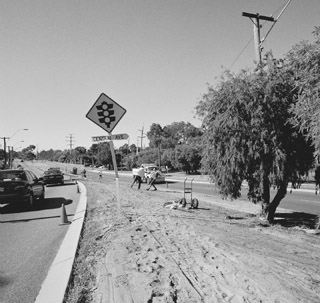Derek Kreckler: something to do with looking
Jena Woodburn

Derek Kreckler, roadside
In 1997, as the result of a successful campaign by Aboriginal activists, the preserved head of an Aboriginal man once displayed in a British museum was returned to Western Australia. Considering this triumphant restoration, Derek Kreckler made the logical progression to a new consideration: where was the body? It could be, he thought, anywhere—underfoot somewhere in Perth, perhaps buried by a roadside waiting for unsuspecting council workers to dig a little deeper…This uncanny notion translates to Kreckler’s ostensibly sunny pictures, most literally in the nature strip and roadside series. Whilst the viewer is not alerted to the story of the souvenired head or the discarded body, its associated unease is hinted at within the odd occurrences of the carefully staged images. In nature strip’s overgrown lot, 2 council workers stare at some discovery hidden to the viewer; whilst working on roadside’s median strip, some event causes one to take a stagy swing at the other, an odd altercation that nevertheless goes almost unnoticed amongst the oblivious passing cars and picturesque bottlebrush.
More blatantly disquieting are the occurrences of the paired bookshop 1 and 2. In the first image, a young Aboriginal woman reads aloud to 2 attentive children as other patrons browse the shelves. In the second image the children are gone and the patrons are felled, one prostrate man oddly attired in heavy boots and pink satin slip. The young woman is seemingly the cause of the destruction: her back to the others, she pulls a book from the shelves with a knowing smile…The more commonplace scenes of brightly-clad council workers engaged in desultory activity also exhibit this sense of narrative, which is particularly enhanced by the arrangement of the photographs in relation to one another. In nature strip 1 the shovel-clasping worker turns towards the other to inspect some discovery yielded by their excavation; in the second photograph he has turned away again and stands, shovel in one hand, the other held over his chest, in traditional gravedigger’s pose. The 2 images work according to classic Eisensteinian montage theory: that which the viewer sees in the first image they then project onto the following, ie, having seen the workman study the hidden find, his subsequent pose is interpreted as reflective. If, as Kreckler originally planned, the images were reversed, the ‘contemplative’ image becomes merely a picture of a council worker standing idly, important only as a foil to the action of the adjacent photograph. Such thoroughness characterises all Kreckler’s images, from their careful composition to their deliberate arrangement and display. It is the artfully staged shots, faultlessly rendered detail—maintained over a considerable depth of field—and the intriguing tableaus that present intimate takes on the seemingly everyday that relates the images, rather than their being merely a presentation of odd occurrences.
For not all the images suggest strange stories: in freezer and salon, the same young woman who appeared in the bookshop series now selects produce from a supermarket and visits a hairdresser without any attendant disasters. The decidedly ordinary events do contrast the obvious peculiarity of the bookshop photographs, and the viewer wonders at the possible relationship. A plausible though tenuous and simplistic correlation seems implied by the exhibition’s title—The Looking and other outcomes—and it is tempting to rely on the explanation this seems to offer, to read into all the photographs something to do with ‘looking’ (scouring the frozen foods, scrutinising a shampoo label). Yet this act is not such a simple one, suggests the title, which posits the act of looking, of searching, as an end in itself. This idea is befitting Kreckler’s carefully composed world where foregone conclusions are overturned and the very idea of conclusion foregone.
Interestingly, it might seem that looking has come to a conclusion in White Pointer, an installation work which draws on the scientific practices of examination and discovery, and its structures of classification and explication for both its themes and substance. In contrast with the sometimes obscure photographs, White Pointer draws determinedly on the factual, its subtitle explicitly explaining to viewers: “you are listening to the sounds of humans observing fish at the New York Aquarium.” The work displays spotlit wall panels copied verbatim from the original explanatory texts of the aquarium, listing the common and scientific names of the housed sea-life, physical descriptions, and the locations in which they might be found. Through 2 white-draped, wall-mounted speakers, recordings of people viewing the creatures in their ‘home’ in New York are transmitted. Thus the very people who were initially inspecting a collection of sharks become in turn the objects of interest for the audience of Kreckler’s own White Pointer. There to inspect the natural curiosities that were collected, organised and displayed for their interest and edification—and according to the same structures that once placed a man’s severed head on display—the aquarium visitors became curiosities in themselves. No recording equipment was visible, but whether the “sounds of humans observing the sounds of humans observing…” features in a subsequent Kreckler work remains to be seen…
Derek Kreckler, The Looking and other outcomes, Contemporary Art Centre of South Australia (CACSA), Adelaide, Nov 2-25
RealTime issue #47 Feb-March 2002 pg. 25






